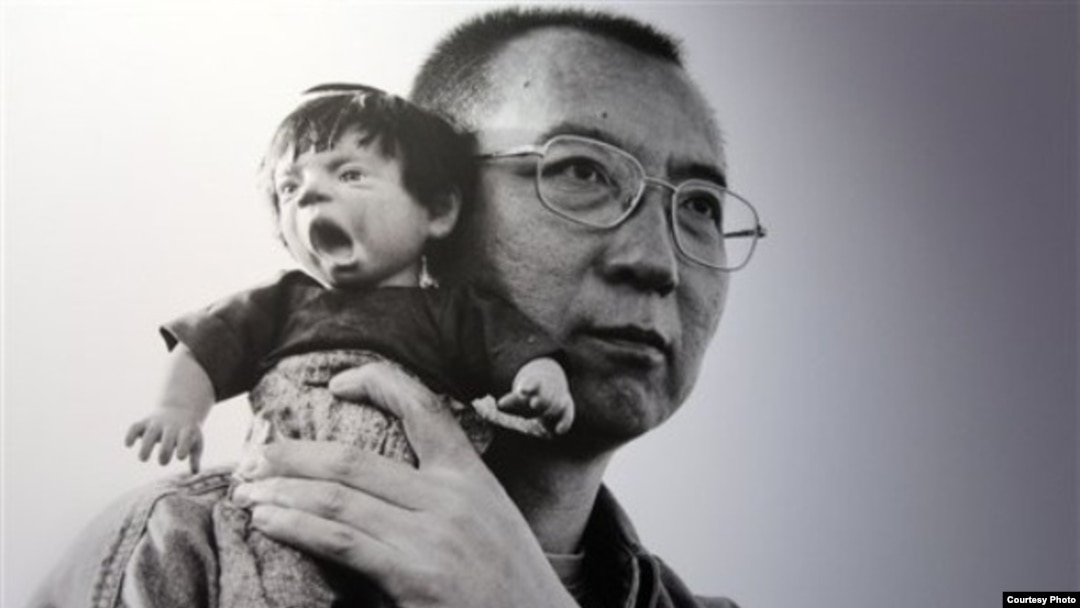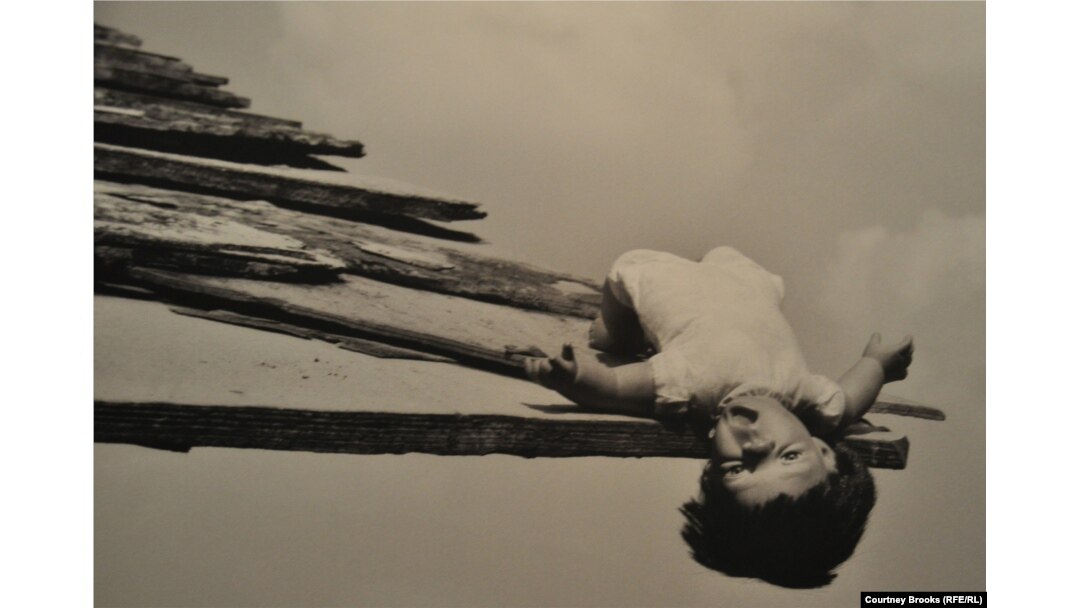NEW YORK -- French writer Guy Sorman was visiting Chinese artist Liu Xia in Beijing when he mistakenly wandered into the bedroom of her tiny apartment and discovered that it was plastered with "ugly babies."
That's how Liu, the wife of jailed human rights activist and Nobel Peace Prize winner Liu Xiaobo, describes the expressive dolls depicted in the large black-and-white prints that so startled Sorman. And thanks to his efforts to smuggle them out of China, those dolls provide a rare glimpse of confinement under an oppressive regime.
"Liu Xia was a bit embarrassed because nobody except a very tiny group of friends in China had ever seen these photos," Sorman says. "She said, 'Well, this is kind of a personal work, it's not to be exhibited.' And I was so impressed by the strength of these photos that I told her that definitely these pictures should be shown to the public."
Twenty-six of the photos, which Sorman says are a metaphorical representation of the suffering faced by the Lius and the Chinese people in general, have been compiled into an exhibition called "The Silent Strength of Liu Xia." The pictures will be on display at Columbia University's Italian Academy in Manhattan through this month.
Liu, who is best known in China for her poetry, took hundreds of photos of the "ugly babies" between 1995 and 2005, a 10-year period during which she and her husband were often confined to their home by Chinese authorities.
She used a Russian camera from the 1970s and developed about 50 prints by turning her tiny kitchen into a darkroom.
"Nearly all of the photos are taken with this old camera, without lights, in their apartment," Sorman says. "And she's able to build all these dramatic stories and metaphors with [such] limited technical resources. I think it is this contradiction which makes the photos really impressive."
Sorman says that in 2010, between Liu Xiaobo's sentencing to a lengthy jail term and her house arrest, she gave him 30 prints with permission to exhibit them abroad. Publicly displaying them in China would have been impossible.
Sorman says trying to take the photos through customs could have drawn unwanted attention, so he opted to have Liu's friends smuggle the pictures out of the country one by one.
Liu Xiaobo, a renowned writer and political activist, was sentenced to 11 years in prison in December 2009 on a charge of "inciting subversion of state power" over his role in writing the "Charter 08," a manifesto calling for greater democratic and economic freedoms.
After visiting her husband in prison following the announcement of his Nobel Peace Prize, Liu Xia herself was placed under house arrest and has been incommunicado ever since.
Sorman says the metaphors in the photos provide clear messages from the couple.
"When you have the photo taken by Liu Xia which is a portrait of Liu Xiaobo carrying a doll on his shoulder, and the doll is crying, this is clearly the Chinese people on the shoulder of Liu Xiaobo," Sorman says. "When you have another doll, which is tied in strings among books, this is Liu Xiaobo being under house arrest in his home and surrounded with books."
Other messages contained in the prints, he says, are more abstract and relate strongly to the Chinese populace as a whole.
"When you have another photo where you have one of the dolls crushed by a huge stone, and on the stone there are very ancient Chinese characters dating back 5,000 years ago, the meaning is that the Chinese will be free when they get rid of the weight of history," Sorman says.
He says one of the captivating aspects of the exhibition is that the message of oppression -- and the appearance of the dolls themselves -- is not specific to China. "Liu Xia could be an artist in Burma, or Zimbabwe, and make the same kind of photos," he says.
Sorman adds, however, that he would implore viewers to see a silver lining in the exhibition: that while no one can deny the Chinese regime represses artists, Liu represents a growing cultural movement of artists and activists that are expressing themselves, whatever the consequence.
"When you go to China, you clearly see the emergence of a civil society," Sorman says. "The people talk their mind and you also discover that there is a huge underground network of artists, and Liu Xia is part of this cultural renaissance."
"The Silent Strength of Liu Xia" will be on display through March 1 before traveling to Madrid and Hong Kong.
That's how Liu, the wife of jailed human rights activist and Nobel Peace Prize winner Liu Xiaobo, describes the expressive dolls depicted in the large black-and-white prints that so startled Sorman. And thanks to his efforts to smuggle them out of China, those dolls provide a rare glimpse of confinement under an oppressive regime.
"Liu Xia was a bit embarrassed because nobody except a very tiny group of friends in China had ever seen these photos," Sorman says. "She said, 'Well, this is kind of a personal work, it's not to be exhibited.' And I was so impressed by the strength of these photos that I told her that definitely these pictures should be shown to the public."
Twenty-six of the photos, which Sorman says are a metaphorical representation of the suffering faced by the Lius and the Chinese people in general, have been compiled into an exhibition called "The Silent Strength of Liu Xia." The pictures will be on display at Columbia University's Italian Academy in Manhattan through this month.
Liu, who is best known in China for her poetry, took hundreds of photos of the "ugly babies" between 1995 and 2005, a 10-year period during which she and her husband were often confined to their home by Chinese authorities.
The Silent Strength of Liu Xia
She used a Russian camera from the 1970s and developed about 50 prints by turning her tiny kitchen into a darkroom.
"Nearly all of the photos are taken with this old camera, without lights, in their apartment," Sorman says. "And she's able to build all these dramatic stories and metaphors with [such] limited technical resources. I think it is this contradiction which makes the photos really impressive."
Sorman says that in 2010, between Liu Xiaobo's sentencing to a lengthy jail term and her house arrest, she gave him 30 prints with permission to exhibit them abroad. Publicly displaying them in China would have been impossible.
Sorman says trying to take the photos through customs could have drawn unwanted attention, so he opted to have Liu's friends smuggle the pictures out of the country one by one.
Liu Xiaobo, a renowned writer and political activist, was sentenced to 11 years in prison in December 2009 on a charge of "inciting subversion of state power" over his role in writing the "Charter 08," a manifesto calling for greater democratic and economic freedoms.
After visiting her husband in prison following the announcement of his Nobel Peace Prize, Liu Xia herself was placed under house arrest and has been incommunicado ever since.
Sorman says the metaphors in the photos provide clear messages from the couple.
"When you have the photo taken by Liu Xia which is a portrait of Liu Xiaobo carrying a doll on his shoulder, and the doll is crying, this is clearly the Chinese people on the shoulder of Liu Xiaobo," Sorman says. "When you have another doll, which is tied in strings among books, this is Liu Xiaobo being under house arrest in his home and surrounded with books."
Other messages contained in the prints, he says, are more abstract and relate strongly to the Chinese populace as a whole.
"When you have another photo where you have one of the dolls crushed by a huge stone, and on the stone there are very ancient Chinese characters dating back 5,000 years ago, the meaning is that the Chinese will be free when they get rid of the weight of history," Sorman says.
He says one of the captivating aspects of the exhibition is that the message of oppression -- and the appearance of the dolls themselves -- is not specific to China. "Liu Xia could be an artist in Burma, or Zimbabwe, and make the same kind of photos," he says.
Sorman adds, however, that he would implore viewers to see a silver lining in the exhibition: that while no one can deny the Chinese regime represses artists, Liu represents a growing cultural movement of artists and activists that are expressing themselves, whatever the consequence.
"When you go to China, you clearly see the emergence of a civil society," Sorman says. "The people talk their mind and you also discover that there is a huge underground network of artists, and Liu Xia is part of this cultural renaissance."
"The Silent Strength of Liu Xia" will be on display through March 1 before traveling to Madrid and Hong Kong.



